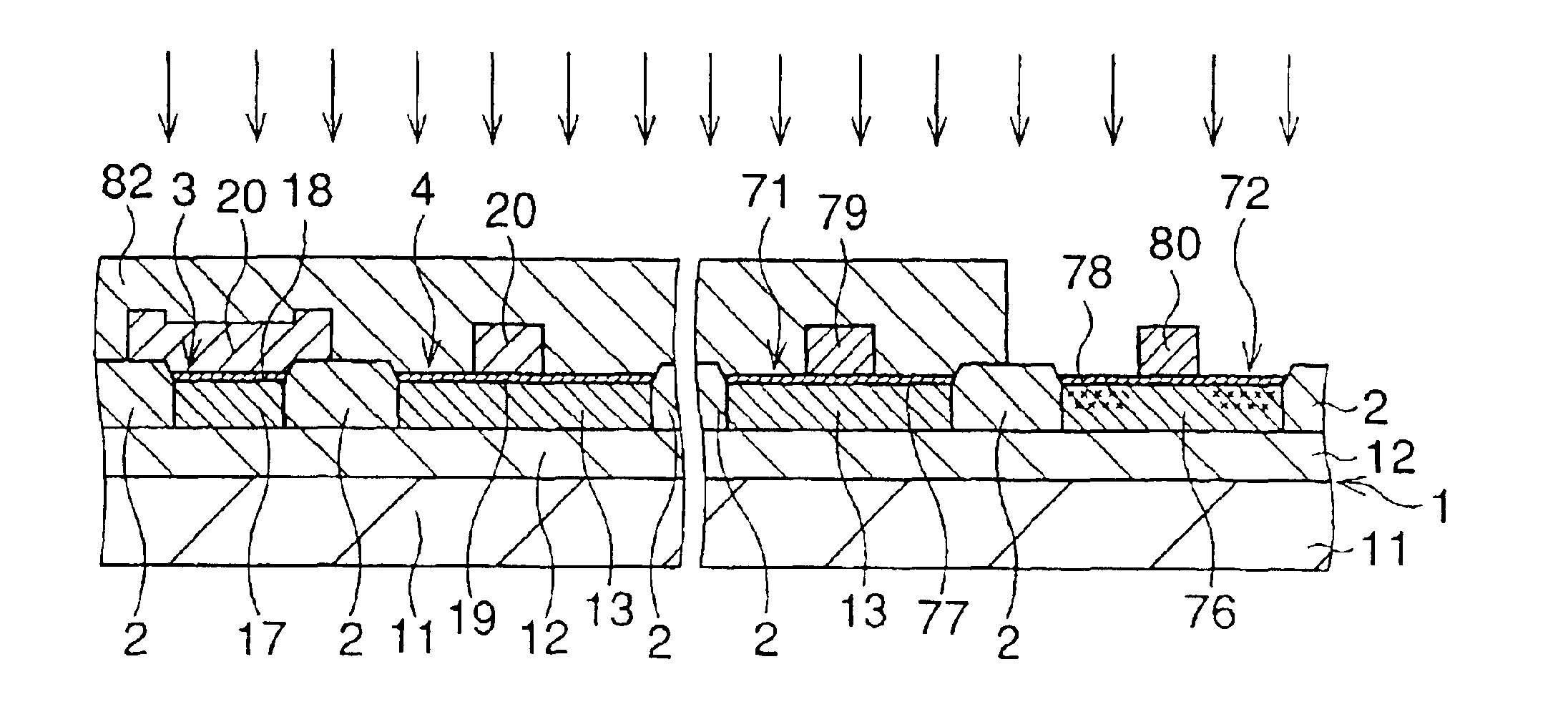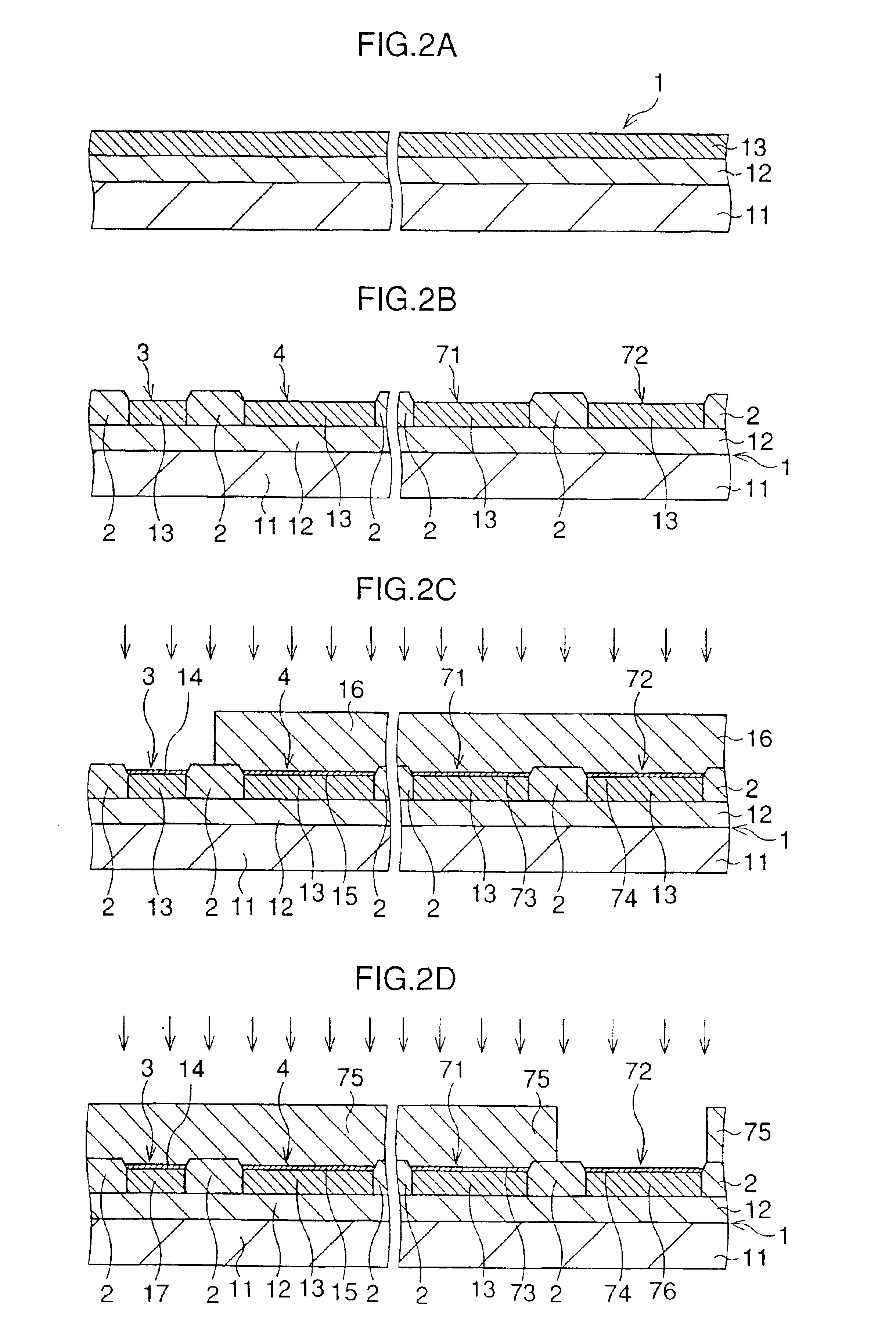Non-volatile semiconductor memory with single layer gate structure
a non-volatile, gate-based technology, applied in the direction of semiconductors, electrical devices, transistors, etc., can solve the problems of increasing the number of fabrication steps and fabrication costs, increasing the accuracy requirements of the element, and the structure of the non-volatile semiconductor memory is complicated, so as to achieve reliable semiconductors, reduce the variation of threshold values, and perform write and read operations stably
- Summary
- Abstract
- Description
- Claims
- Application Information
AI Technical Summary
Benefits of technology
Problems solved by technology
Method used
Image
Examples
first embodiment -
-First Embodiment-
The first embodiment will be described below. In this first embodiment, an EEPROM as a nonvolatile semiconductor memory will be exemplified as a semiconductor device, and the structure and the fabrication method of this EEPROM will be explained. Also, a method of forming a CMOS inverter as a peripheral circuit simultaneously with the formation of the EEPROM will be explained. FIG. 1 is a schematic plan view showing the EEPROM and the CMOS inverter. FIGS. 2A to 2I are schematic sectional views, taken along an alternate long and short dashed line I—I in FIG. 1, showing the fabrication method of the EEPROM and the CMOS inverter in order of steps.
First, as shown in FIG. 2A, an SOI substrate 1 is prepared by forming a single-crystal silicon layer 13 about 50 nm thick on a p-type silicon semiconductor substrate 11 via a buried oxide film 12 about 50 nm thick.
Next, as shown in FIG. 2B, the SOI substrate 1 is selectively oxidized to form a field oxide film 2 about 100 nm t...
second embodiment -
-Second Embodiment-
The second embodiment of the present invention will be described below. In this second embodiment, the structure and the fabrication method of an EEPROM will be explained as in the first embodiment. However, the second embodiment differs from the first embodiment in that no SOI substrate is used and trench isolation is used as element isolation. FIG. 4 is a schematic plan view showing this EEPROM. FIGS. 5A to 5I are schematic sectional views, taken along an alternate long and short dashed line I—I in FIG. 4, showing the method of fabricating the EEPROM in order of steps performed. Note that the same reference numerals as in the EEPROM of the first embodiment denote the same parts in the second embodiment and a detailed description thereof will be omitted.
First, as shown in FIG. 5A, the surface of a p-type silicon semiconductor substrate 31 is coated with a photoresist about 1.5 μm thick via a silicon oxide film 32 about 50 nm thick. This photoresist is processed b...
third embodiment -
-Third Embodiment-
The third embodiment of the present invention will be described below. In this third embodiment, the structure and the fabrication method of an EEPROM will be explained as in the first embodiment. However, the third embodiment differs from the first embodiment in that a SIMOX method is used. FIG. 7 is a schematic plan view showing this EEPROM. FIGS. 8A to 8H are schematic sectional views, taken along an alternate long and short dashed line I—I in FIG. 7, showing the fabrication method of the EEPROM in order of steps. Note that the same reference numerals as in the EEPROM of the first embodiment denote the same parts in the third embodiment, and a detailed description thereof will be omitted.
First, as shown in FIG. 8A, a silicon oxide film 43 about 1.5 to 2.0 μm thick is deposited by CVD on a p-type single-crystal silicon semiconductor substrate 41 via a silicon oxide film 42 about 100 nm thick. Photolithography and dry etching are sequentially performed on this sil...
PUM
 Login to view more
Login to view more Abstract
Description
Claims
Application Information
 Login to view more
Login to view more - R&D Engineer
- R&D Manager
- IP Professional
- Industry Leading Data Capabilities
- Powerful AI technology
- Patent DNA Extraction
Browse by: Latest US Patents, China's latest patents, Technical Efficacy Thesaurus, Application Domain, Technology Topic.
© 2024 PatSnap. All rights reserved.Legal|Privacy policy|Modern Slavery Act Transparency Statement|Sitemap



